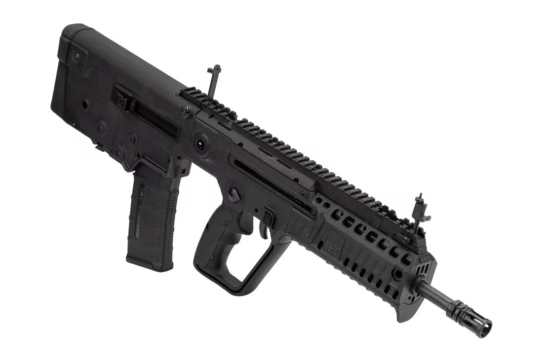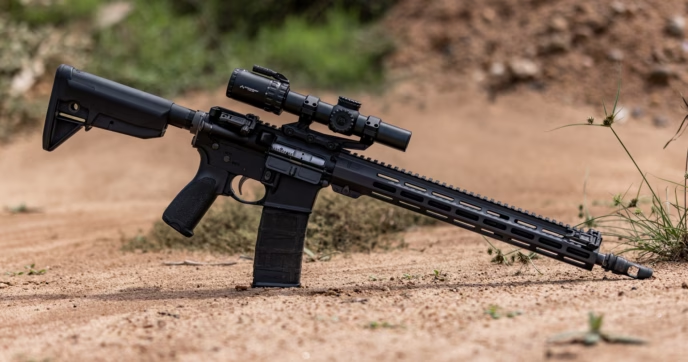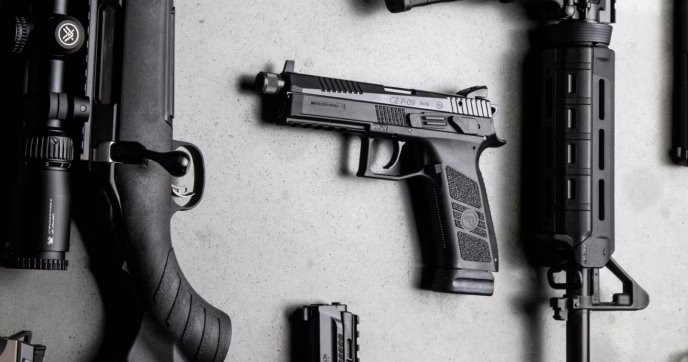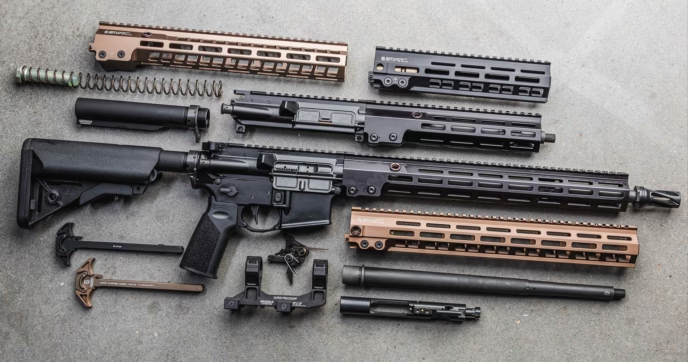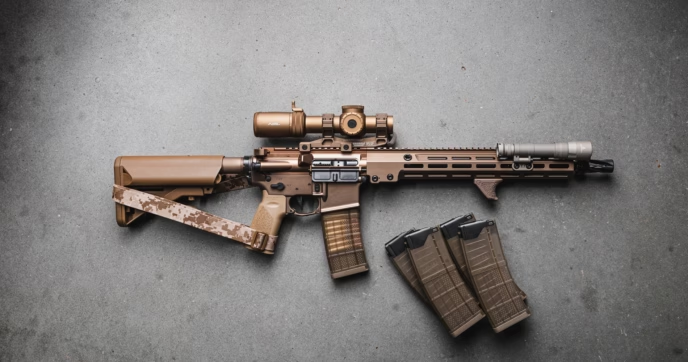The modern firearms market is saturated with a plethora of high-quality rifle models. And while you may already be familiar with industry favorites such as the various AR platform rifles, AKM, SIG MCX, and more, part of the allure that gets so many new enthusiasts into shooting is the vast range of different makes and models to choose from. And one of the most eye-catching subsets of modern rifles are bullpups.
Bullpups are a unique offshoot from traditional rifle designs. Offering a highly compact form-factor, bullpups are designed so that the action and magazine are behind the grip, creating an ultra-compact rifle that’s capable of housing a 16.5-inch barrel while maintaining an overall length of less than 30 inches.
Because of their unique design and size advantages, it’s easy to understand why they’ve become so popular, especially since the market is dominated by rifles like the AR-15. Still, although capable, bullpups aren’t for everyone. And just like with any other rifle, they come with their own unique pros and cons.
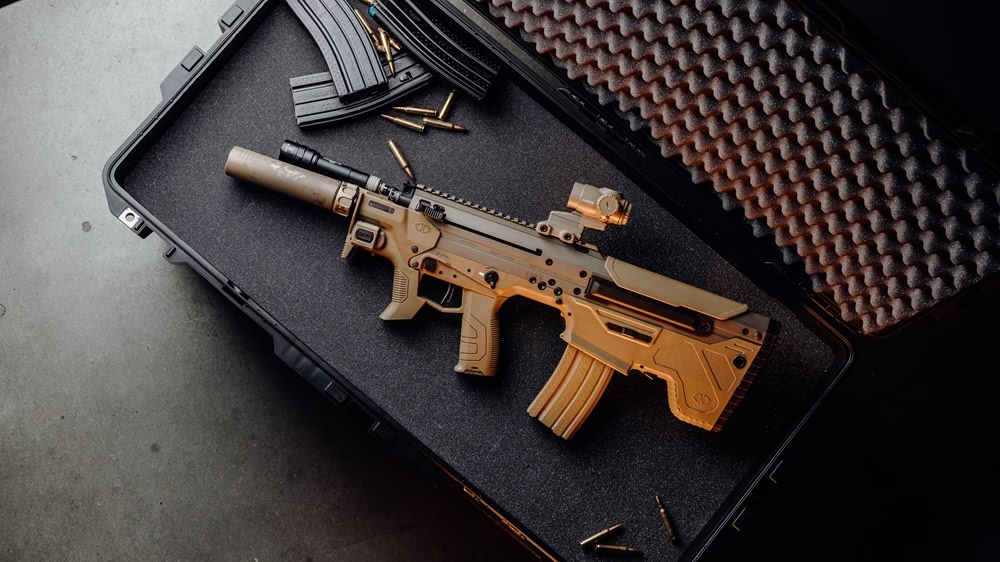
What is a Bullpup and how do they work?
As we mentioned above, a bullpup is simply a rifle that’s been engineered to house the action and magazine behind the grip and trigger. These rifles are gas operated, just like other semi-auto rifles, but they feature more complex internal designs to make using the rifle possible.
For instance, the firing process is the same on bullpups as it is on other rifles, but since the trigger is in front of the action and hammer, bullpup triggers use a linkage that stretches all the way back to the action to start the firing process. In the same vein, the bolt and carrier on these are functionally the same as well, but they have a specialized design to make them functional in their less conventional receiver design.
Why are they called ‘Bullpups’?
It’s difficult to pinpoint the exact origins of the term ‘bullpup’ and how it became associated with these rifles. Some of the earliest references to such rifles can be traced back to the 1930s, with the term being analogous of bulldog puppies. Later it began to be used in a derogatory sense to describe something as ugly yet still powerful, and eventually, people began to use it to describe more compact versions of conventional firearms, leading to the colloquialization of the term. On a sidenote, it’s worth mentioning that the term ‘bullpup’ is not a true official designation for such firearms, but rather a nickname that stuck to rifles that place the action behind the trigger.

History of Bullpups
To the uninitiated, bullpup rifles may appear to be a concept developed recently, but they’ve been around for a long time. The earliest recorded design resembling what we now would call a bullpup design was created by Richard Potter in London—a prototype heavy bench-rest style target rifle. One of the first patented bullpup rifle designs was created not long after 1866, and later again, in 1901, with the creation of the Thorneycroft Carbine.
Still, bullpups, at least as we know them today, wouldn’t begin cropping up until after WWII. Following the war, many nations began developing new firearms with an emphasis on compact utility. Designs like the British EM-2 and Russian TKB-408 are among the most notable examples, but neither one would make it past the prototype/testing stage of development. It wouldn’t be until 1977 that the first truly successful bullpup would be introduced in the form of the Steyr Aug. These rifles were reliable, accurate, and compact, leading to its adoption by both the Austrian and Australian Military, while also setting the standard for what was possible with such rifles.
On the civilian market, bullpup rifles are immensely popular, with there being a plethora of models to choose from. And like the AR-15 and AR-10, they have a large and rapidly growing parts aftermarket as well.
Pros of Bullpup Rifles
Compact Size and Maneuverability
One of the standout advantages bullpup rifles offer is their compact size. By having the action placed towards the rifle’s rear, they can have a full-length barrel with a short overall length. For instance, the Tavor 7 (a rifle we’ll highlight later) has a 16.5-inch barrel, but an overall length of 26.75 inches. Meanwhile an AR-15 with a 16-inch barrel with a fully collapsed stock would have an OAL of around 32.5 inches.
In addition to their compact size, most of the rifle’s weight is in the rear, which gets tucked into your shoulder, leaving the muzzle-end of the rifle very lightweight. This, paired with the rifle’s shorter length, makes it incredibly easy to get around corners and other tight spaces, giving you a level of maneuverability that’s on par with an SBR while still having a rifle-length barrel.
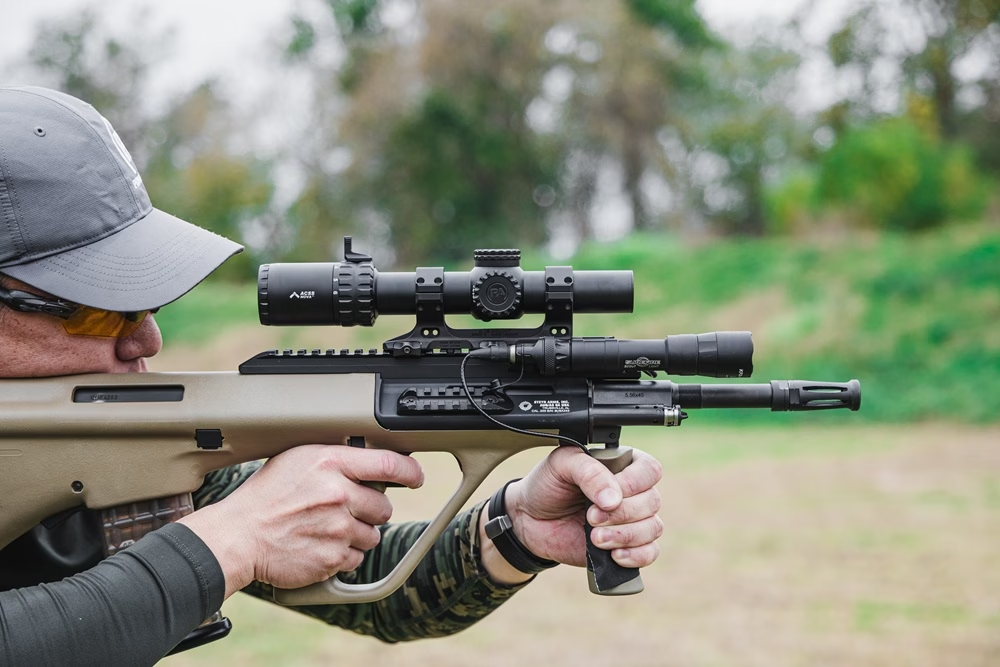
Improved Balance
Another advantage of running a bullpup is their balance. Generally, bullpups are quite back heavy by design, but once shouldered, they’re balanced quite well, making it easy to accessorize your rifle without affecting its balance all that much. On traditional rifles, adding accessories and other gear like weapon lights, IR lasers, and muzzle accessories like suppressors can have a serious impact on your rifle’s balance and handling. While you’ll still need to be aware of weight when accessorizing your rifle, you likely won’t have many weight or balance issues when running a bull pup.
Optimal Barrel Length
Despite their compact appearance, bullpups are capable of housing a wide array of barrel lengths, ranging anywhere from as short as 11.5 inches (in SBR configurations) to upwards of 20+ inches. No matter the caliber, longer barrels generally increase a rifle’s effective range, accuracy, and precision. Take 5.56 NATO for instance. For general purpose use, you’d ideally want to have a 14.5-to-16-inch barrel, and with a bullpup rifle, you’d be able to achieve this easily while still maintaining a shorter overall length than conventional rifles.
Cons of Bullpup Rifles
Trigger Feel and Ranged Performance
Although bullpups have many pros, they have their share of cons that stem from their unconventional designs, the greatest of which are their triggers. Bullpups are notorious for having less-than-ideal feeling triggers. This is primarily due to the linkage needed for them to work. Because of their trigger linkage, bullpups tend to have heavier trigger pull weights and longer travel than conventional rifle triggers. Theis isn’t universal though, as some bullpups, such as those by Desert Tech, have good triggers out of the box—and most other bullpups can be upgraded with aftermarket trigger packs.
Bullpups often aren’t the best options for long-range use, despite their ability to house longer barrels. Aside from rifles like the WLVRN from Desert Tech, most, if not all, bullpups lack true free-floating barrels, resulting in poorer barrel harmonics since they’re in more direct contact with the rest of the rifle. Even further, while the balance of bullpups makes them exceptional for CQB applications, the lack of weight towards the muzzle makes them particularly sensitive to movement, with even small adjustments having a significant effect on their practical accuracy.
Plus, because of their design, going prone with one can be a bit tricky as well. Since the magazine sticks out below where the buttstock is, your ability to adjust up and down is limited, making shots at longer distances that require holds to compensate for bullet drop a bit of a challenge.
Ergonomics
Ergonomically, bullpups aren’t for everyone. Because the ejection port is in the rear, often close to the user’s face, they can challenge left-handed enthusiasts. While it’s more common to find ambidextrous bullpup rifles nowadays, not every option is, so it’s imperative to double-check the rifle’s dexterity before buying. If you’re a lefty using a right-handed bullpup, your face will be directly in the casing’s ejection path. Something else to note is that you can’t just freely swap from left- to right-hand ejection with a bullpup. They require you to disassemble the rifle and manually reposition the bolt and other components to make it as such. This also means that you won’t be able to swap shoulders freely like you could with an AR.
Additionally, bullpups don’t typically come with adjustable buttstocks, limiting you to only one possible length of pull. This isn’t true for all models, as the Springfield Hellion—another rifle we’ll go more in-depth on later—comes with an adjustable buttstock. For other models, though, you’re locked into one length of pull unless there’s an aftermarket recoil pad available.
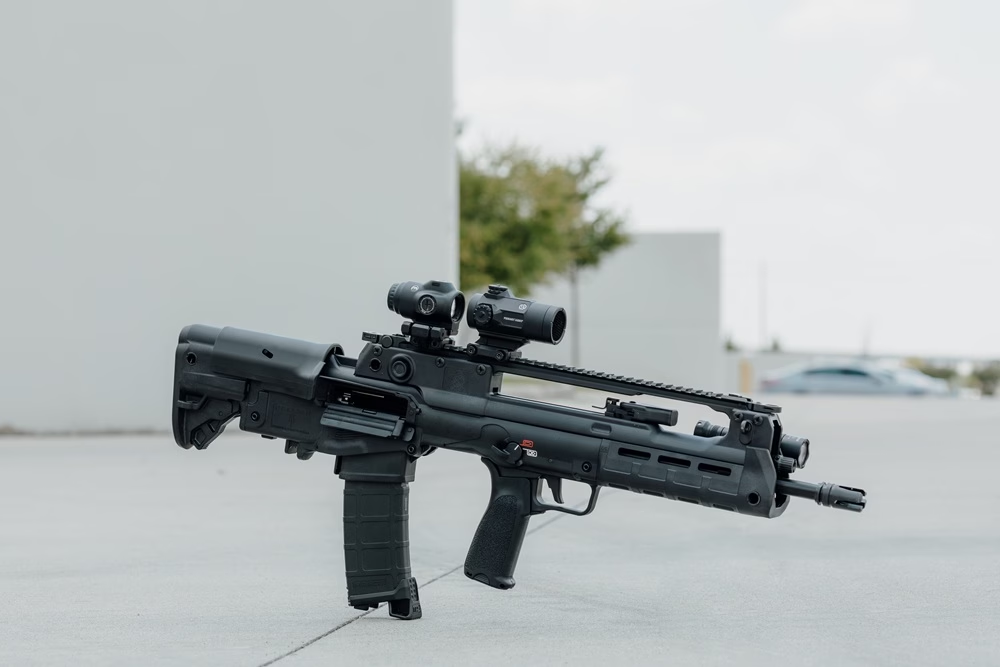
Challenges with Reload Speed
Additionally, due to their untraditional magazine well location, bullpups have a slight learning curve when it comes to making quick reloads. On most rifles, the mag release is near the trigger in, but the bolt catch is usually close to the mag well, meaning you’ll have to get some practice with your rifle’s mechanics to become proficient.
This isn’t necessarily a true con per se, but if you’re already used to a traditional rifle’s manual of arms, it can take some time to hone your skills with a bullpup.
Customization Constraints
As we’ve mentioned several times by now, bullpups are designed to be compact, and as a result, they don’t offer as much rail space for accessories. Granted, this is dependent on the model rifle you opt for. With popular bullpups like the Tavor and Hellion, you’ll still have enough mounting space to add optics, lights, lasers, and grips, but your setup might be a bit cramped.
Fortunately, as bullpups become more popular, their respective parts aftermarket will continue to expand to make accessory mounting and their overall utility much better. Specialized components like extended handguards are already available for some rifles, so it’s more than possible to work around each rifle’s design constraints.
Popular Bullpup Rifles
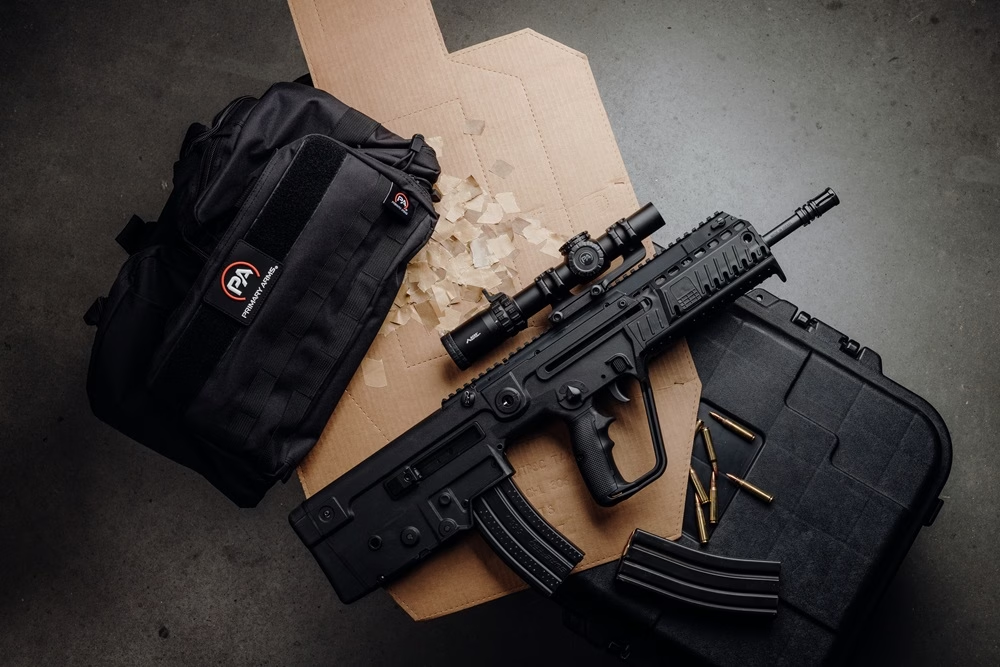
IWI Tavor
Israeli Weapon Industries has been a prominent name in the firearms industry for a long time, and though their lineup consists of some big names like their Zion series AR-15s and Carmel carbine, one of their most popular offerings is the Tavor bullpup rifle. The Tavor is offered in a couple of different configurations, with the most notable ones being the Tavor X95 and Tavor 7.
Building on the foundation of the Tavor SAR, the IWI Tavor X95 5.56 bullpup rifle is a lighter option designed to offer better ergonomics and enhanced modularity compared to its predecessor. Utilizing a long-stroke gas piston system, they offer battle-proven reliability that’s ready for all scenarios. Currently, they’re only available in 5.56 NATO, coming with either a 16.5- or an 18.5-inch barrel—they’re also available in an SBR configuration with a 13-inch barrel too. X95 rifles were offered in .300 Blackout and 9mm for a brief time, but as of right now, they aren’t offered anymore.
Aside from this, they come standard with picatinny rail mounts on the forend, which can be covered with the included rail covers for a more comfortable grip. Also, the top of the rifle features a continuous upper picatinny rail and an integrated set of flip-up iron sights. Lastly, the Tavor X95 is ambidextrous, coming with a reversible ejector and Ambi controls.
The IWI Tavor 7 .308 Bullpup Rifle is a compact battle rifle chambered in 7.62 NATO, and though it’s part of the Tavor family, its design isn’t one-to-one with the X95. Aside from their size and caliber differences, the Tavor 7 uses a short-stroke gas piston instead of a long-stroke one, and its design is more reminiscent to the original Tavor SAR.
Instead of having multiple picatinny rail mounts, the Tavor 7 uses a combination of M-LOK and picatinny. The bottom of the forend has a removable panel that covers a picatinny rail, while the sides of the forend have integrated M-LOK slots. Lastly, these rifles are currently offered with a 16.5-inch barrel.
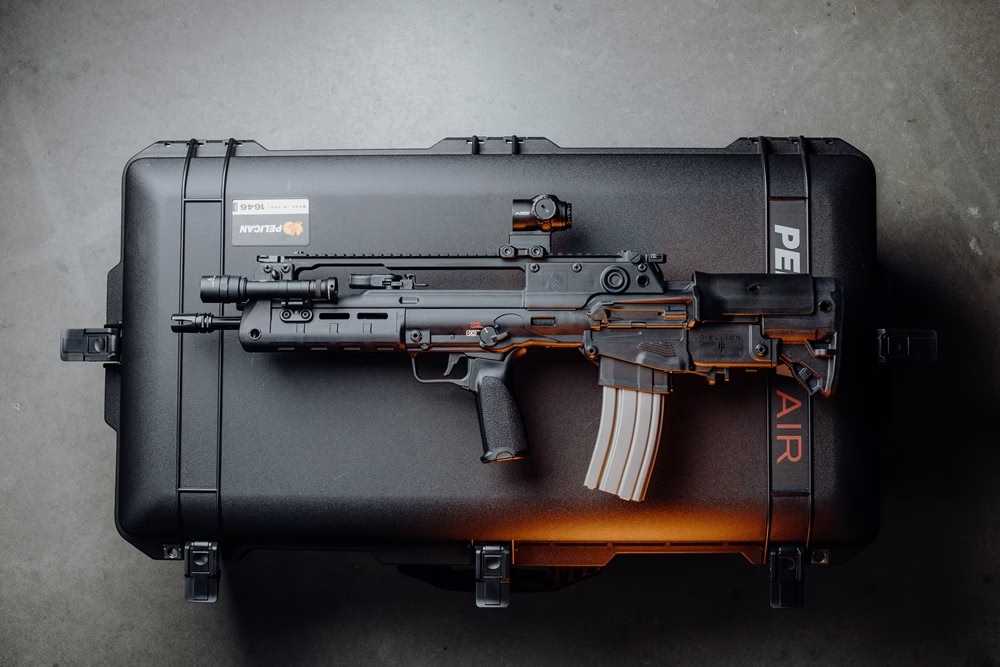
Springfield Hellion
Springfield Armory is another iconic name in the industry, known for producing a vast assortment of rifles and pistols. Despite being most well-known for the M1A and their assortment of 1911s, one of their newest additions, the Hellion, has garnered a substantial following.
At its core, the Springfield Armory Hellion 5.56 Bullpup Rifle is a civilian variant of the Croatian standard issue service rifle, the VHS-II. The Hellion is a fully ambidextrous bullpup that’s equipped with a reversible ejector and charging handle. Currently, these rifles are only offered in 5.56, but they can come with your choice of either a 16-, 18-, or a 20-inch barrel. Additionally, the Hellion comes standard with M-LOK compatibility on all sides of the forend, and unlike many other bullpups, it has an adjustable stock. Plus, it’s even compatible with standard AR pistol grips, so you’ll be able to easily customize the rifle to better fit your preference.
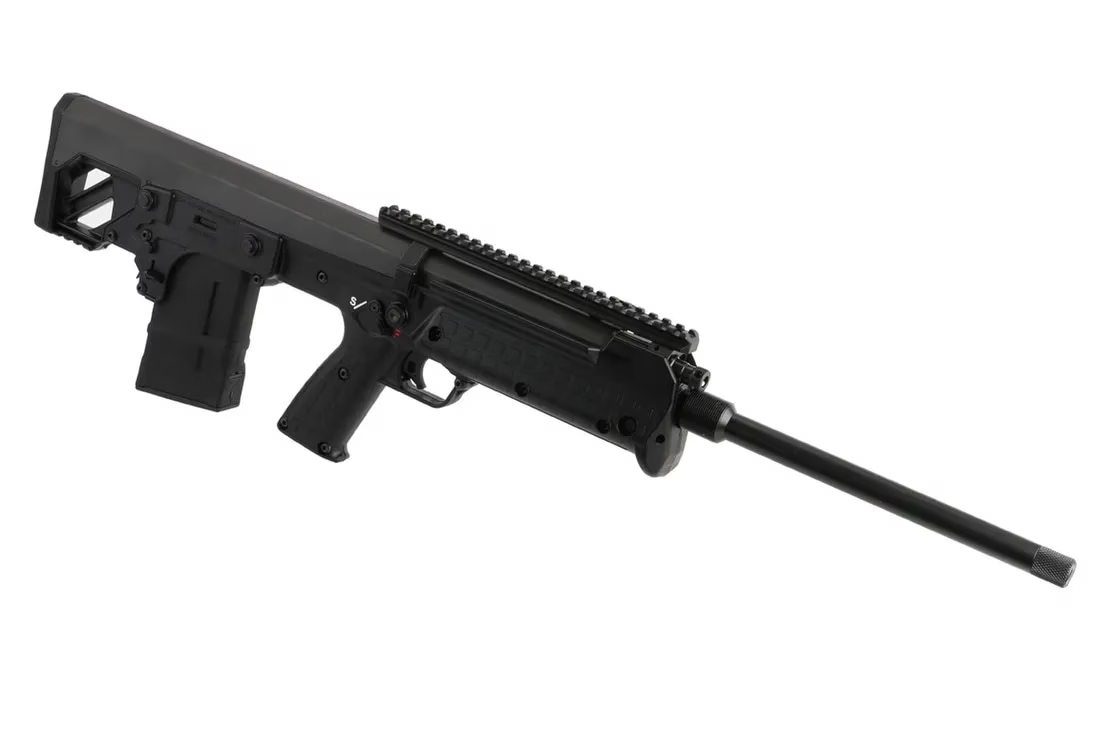
Kel-Tec RFB
Kel-Tec produces some of the most unique firearms in the industry, ranging from various pistols and rifles to specialized shotguns. Among their vast rifle lineup is the Kel-Tec RFB18 .308 bullpup, another incredibly unique rifle to consider.
Chambered in .308, they’re available in two specific configurations—Carbine and Hunter—which come equipped with an 18.5- and 24-inch barrel, respectively. The RFB utilizes a short-stroke gas piston system, and it comes with an adjustable gas block for optimal use with different ammo loads or suppressors. Unlike the other models mentioned thus far, the RFB doesn’t eject spent casings out the side of the receiver. Instead, it uses a patented forward ejection system, reminiscent of older bullpups like the FN FS2000, meaning you can use this rifle regardless of your dexterity.
Something else to note is that, even though it’s chambered in .308, the RFB doesn’t use conventional SR-25 pattern magazines like the Tavor 7. Instead, it uses FAL pattern magazines, which aren’t as commonly available, though they aren’t impossible to find.
Conclusion
So, are bullpups the ultimate rival rifle for the AR-15, AR-10, and others? It’s hard to say—while they certainly have their advantages over traditional rifle platforms, by design, they have their share of limitations to consider.
Ultimately, choosing a bullpup over a conventional rifle is totally up to user-preference. They offer several advantages such as their compact overall length, and ability to house full-length rifle barrels, giving you all the benefits of a long gun in a package that’s roughly the same size as your average SBR.
Despite these benefits though, it’s important to recognize that bullpups aren’t without their cons, the greatest of which is, arguably, their ergonomics. If you aren’t already used to running a bullpup, getting used to their manual of arms can take some time, and they won’t offer the same level of customizability as something like an AR-15 or AR-10, though it’s still possible to accessorize your rifle if you have the right gear.
At the end of the day, bullpups can be an effective rifle platform that’s capable of being built up to suit a myriad of scenarios. So, if you think they’ll be a good fit for you, we highly recommend checking them out.
